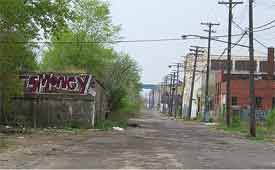At its population height in the 1950’s, Detroit, once the 4th largest city in America had almost 2 million residents. Today, amidst abandoned homes, dilapidated warehouse buildings, and empty lots, only about 750,000 residents remain.
Detroit, with a large geographic area occupying about 140 square miles, 40 of those square miles are on vacant land.
Not a single supermarket exists within its city limits! [An astute reader sent me an email, and a link to a post: “Yes There Are Grocery Stores in Detroit” that seeks to debunk the apparent myth that Detroit has no large food markets inside the city. The upshot: yes, Detroit has a mix of independent food markets (also public food gardens and farmer’s markets), although not associated with any of the national chain supermarkets. Nonetheless, there are apparently stores where residents can buy (if they can afford it) fresh fruits, vegetables, and meats—the standard fare of items one would expect to find at the national chain stores.]
But the once great city may offer a brighter future not only for itself, but for the state of Michigan, and the country, as well. As Mike Hamm, C. S. Mott Professor of Sustainable Agriculture at Michigan State University (MSU), and head of the C.S. Mott Group for Sustainable Food Systems explains in this interview, even our national security depends upon the need to develop local and regional food systems that are resilient and able to withstand inevitable future disruptions. Pointing to the effect of the recent earthquake in Japan that caused immediate supply chain problems in the electronics industry, our over-extended global food system is vulnerable to similar types of singular stress points.
According to professor Hamm, Detroit offers unique opportunities to develop a sustainable food system that involves both urban agriculture development, and also partnership with rural communities to produce, distribute, and process a diverse mix of fruits, vegetables, and meats to eaters. With an anticipated increase of 2.5 billion in the global population over the next 40 years, Hamm translates that growth for the need to produce up to 3.4 trillion pounds of additional food. On the national level, Hamm attributes our share of extra food production required to be about 140 million pounds of food to feed an additional 100 million U.S. residents.
Throwing into the mix, the critical need for more land for production agriculture, the future availability of less water, the need for less energy consumption, urban areas are likely to become increasingly important food production centers to meet the national demand. Not only does Detroit have land within its borders for growing fruits and vegetables, rural areas within the state, and midwest region, also have capacity to grow additional food. As Hamm points out, although California is our largest national food production zone today, its production capacity is likely to shrink over time.
Check out this excellent audio interview about the efforts, and the need to create regional food systems in the Detroit area: Mike Hamm: Urban farms could provide a majority of produce for Detroiters

